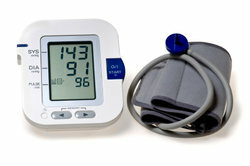What is blood pressure
"Blood pressure" is actually a medical term that is on everyone's lips. But what exactly is physically understood by this term?

What you need:
- Basic knowledge of "physics"
The heart makes the blood pressure
- Pumping can be used to generate pressure in liquids. The blood circulation is also maintained by pressure generated by the heart muscle.
- This blood pressure depends on the capacity of the heart as well as on the width of the veins and their elasticity.
- This pressure generated by the heart muscle is of course not constant, but rather shows rhythmic fluctuations that depend on the respective activity phase of the heart.
- In addition, the values are not the same in all veins: the further you are from the heart, the lower the pressure.
- When the heart contracts (also called systole in medical terms), it pushes the blood into the thick-walled arteries at high pressure. This pressure is known as the systolic (and upper) blood pressure value.
- During the relaxation of the heart (called diastole) the enlarged blood vessels due to the elasticity of the connective tissue and increase the active work of muscles in their walls back to their normal diameter and in this way regulate the (further) Blood flow. This ensures a steady flow of blood even when the heart is resting. The value measured at this moment is the lower, diastolic value.
- During each individual beating period of the heart, your blood pressure fluctuates between the systolic as the highest and the diastolic as the lowest value.
What does the air pressure depend on? - A simple explanation
The air pressure is created by the air atmosphere that surrounds us. But what does it depend on ...
Pressure is a physical quantity
- Pressure as a physical quantity is defined as the force acting on a surface divided by the size of the surface. In response to the activity of the heart, blood pressure is created when the muscle exerts pressure on the cross-sectional area of the artery.
- The international unit of pressure is the "Pascal" (abbreviation "Pa").
- However, the pressure unit "mm of mercury" or "mm Hg" for short has been used in the medical field to this day. The conversion is: 1 mm Hg = 133 Pa.
- The two values described above are around 120/80 mm Hg in young adults (i.e. 120 to 80; the values naturally vary from person to person and also under stress). The systolic blood pressure is therefore 120 mm Hg and the diastolic 80 mm Hg. For comparison: the atmospheric Air pressure is 760 mm Hg. This shows you in which sensitive area the human circulatory system is is working.
- The veins have the task of collecting the blood again and supplying it to the heart. There it only flows with a very low pressure of 10-20 mm Hg.
How helpful do you find this article?

